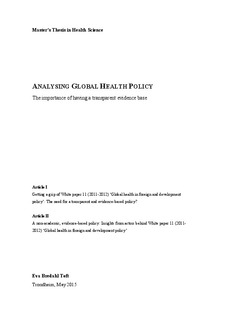Analysing global health policy - The importance of having a transparent evidence base
Master thesis
Permanent lenke
http://hdl.handle.net/11250/298813Utgivelsesdato
2015Metadata
Vis full innførselSamlinger
- Institutt for sosialt arbeid [1393]
Sammendrag
Introduction article 1: Evidence-based policy is crucial in improvement of global health. White paper 11 (2011-2012) ‘Global health in foreign and development policy’ was the first white paper on global health, presented by a Ministry of Foreign Affairs. In the policy, the use of references to research evidence is lacking, which means its knowledge base isn’t transparent. One of White paper 11’s top priorities is mobilising for women’s and children’s rights and health. The article seeks to illustrate why it is importance to have transparency in a policy. This is tried achieved, by finding evidence, on women’s and children’s health with focus on the impact of malnutrition and comparing it with the argumentation stated in the white paper. Because, when a policy is transparent, the reader can judge its evidence base and priorities argumentation. Thereby can the trust in the policy and the actors responsible for its making, increase. Furthermore, can transparency give the reader opportunity to hold the actors accountable, whether the policy’s outcome has been good or bad.
Introduction article 2: In 2013, proximately 17.000 children under five died every day around the world. They died mostly by preventable causes and diseases that can be treated by well-known knowledge and technologies for lifesaving interventions. White paper 11 (2011-2012) ‘Global health in foreign and development policy’ was the first white
paper on global health presented by a ministry of foreign affairs. Therefore, it’s important to investigate the process behind the policy, since it, among other things, can have big impact on how the political sphere and global Health interest work. Aim: To investigate politicians’ and policymakers’ view and experiences with the process of making
the white paper, their thoughts on how it should be used, how the policy’s knowledge base is used and how it came about. Method: Qualitative semi-structured interview study with five participants, consisting of politicians and policymakers. Findings: The participants described the collaboration with Global Alliance for Vaccines and
Immunization (GAVI) and the program of vaccinating the children of the world as flagship for White paper 11. The process was seen as open and involving and the knowledge base was used to show direction of the policy, rather than stating the reasons. There was found a difference in culture between the involved ministries in accordance with the
design of the policy. Further, White paper 11 was seen as a tool both for politicians and policymakers and also as a political paper, rather than an academic one. Conclusion: Evidence is just a part of different contributing elements in the process of making evidence-based policy. Nevertheless, this study found that it’s crucial to have a transparent knowledge base, when writing white papers, because it can have multiple consequences if not enforced.
